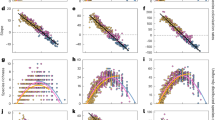Abstract
In this chapter, extinctions are explored in the context of mechanisms that operate during and after habitat fragmentation of, and with frequent references to, woodlands in farmland, where we have studied the process, although information from many other situations are also used. An ecotone that is relevant to a particular species must be a gradient from more survivable to less survivable conditions. A high density of these circumstances should be conducive to observing the processes of local extinction. Fragmentation creates ecotones, expands them, and moves them. Therefore, from the information that we have about fragmentation effects, it may be possible to learn about the effects of changing ecotones on species extinctions.
Access this chapter
Tax calculation will be finalised at checkout
Purchases are for personal use only
Preview
Unable to display preview. Download preview PDF.
Similar content being viewed by others
References
Addicott JF (1978) The population dynamics of aphids on fireweed: a comparison of local and metapopulations. Can J Zool 56:2554–2564
Andren H, Angelstam (1988) Elevated predation rates as an edge effect in habitat islands: experimental evidence. Ecology 69:544–547
Andrewartha HG, Birch LC (1984) The Ecological Web. University of Chicago Press, Chicago
Bauchau V, Le Boulangé E (1990) Population biology of woodland rodents in a patchy landscape. In Le Berre M, Le Guette L (eds) Le Rongeur et l’Espace. R. Chabaud, Paris, (in press)
Belovsky G (1987) Extinction models and mammalian persistence. In Soulé ME (ed) Viable Populations for Conservation. Cambridge University Press, Cambridge, UK, pp 35–57
Blaustein AR (1981) Population fluctuations and extinctions of small rodents in coastal southern California. Oecologia 48:71–78
Brittingham MC, Temple SA (1983) Have cowbirds caused forest songbirds to decline? BioScience 33:31–35
Brown JH, Kodric-Brown A (1977) Turnover rates in insular biogeography: effect of immigration on extinction. Ecology 58:445–449
Comins HN, Hamilton WJ, May RM (1980) Evolutionarily stable dispersal strategies. J Theoret Biol 82:205–230
Crowell KL (1973) Experimental zoogeography: introductions of mice to small islands. Am Nat 107:535–558
Crowell KL (1983) Islands—insight or artifact? Population dynamics and habitat utilization in insular rodents. Oikos 41:442–454
den Boer PJ (1981) On the survival of populations in a heterogeneous and variable environment. Oecologia 50:39–53
Ehrlich PR (1965) The population biology of the butterfly, Euphydras editha. II. The structure of the Jasper Ridge colony. Evolution 19:327–336
Ehrlich PR (1983) Genetics and the extinction of butterfly populations. In Schoneweld-Cox C, Chambers S, MacBryde B, Thomas W (eds) Genetics and Conservation: A Reference for Managing Wild Animal and Plant Populations. Benjamin/Cummings, Menlo Park, California, pp 152–163
Ehrlich PR, Murphy DD, Singer MC, Sherwood CB, White RR, Brown LL (1980) Extinction, reduction, stability and increase: the response of checkerspot butterfly populations to the California drought. Oecologia 46:101–105
Fahrig L, Merriam G (1985) Habitat patch connectivity and population survival. Ecology 66:1762–1768
Frankel OH, Soulé M (1981) Conservation and Evolution. Cambridge University Press, Cambridge, UK
Freemark KE (1988) Agriculture, disturbance and landscape management. In Moss MR (ed) Landscape Ecology and Management. Polyscience Publishers, Montreal, pp 77–84
Freemark KE, Merriam G (1986) Importance of area and habitat heterogeneity of bird assemblages in temperate forest fragments. Biol Conserv 36:115–141
Fritz RS (1979) Consequences of insular population structure: distribution and extinction of spruce grouse populations. Oecologia 42:57–65
Gill DE (1978) The metapopulation ecology of the red-spotted newt, Notophthalmus viridescens (Rafinesque). Ecol Monogr 48:145–166
Gilpin ME (1987) Spatial structure and population vulnerability. In M Soulé (ed) Viable Populations for Conservation. Cambridge University Press, Cambridge, UK, 125–138
Gilpin ME (1989) Extinction of finite metapopulations in correlated environments. In Shorrocks B, Swingland I (eds) Living in a Patchy Environment. Oxford University Press, Cambridge, UK, pp 177–186
Goodman D (1987) The demography of chance extinction. In M Soulé (ed) Viable Populations for Conservation. Cambridge University Press, Cambridge, UK, pp 11–34
Hanski I (1989) Metapopulation dynamics: does it help to have more of the same? TREE 4:113–114
Hansson L (1979) On the importance of landscape heterogeneity in northern regions for the breeding population densities of homeotherms. Oikos 33:182–189
Hansson L, Hentonnen H (1988) Rodent dynamics as community processes. Trends in Ecol and Evol 3:195–200
Harris LD (1984) The Fragmented Forest. University of Chicago Press, Chicago
Henderson M, Merriam G, Wegner J (1985) Patchy environments and species survival: chipmunks in an agricultural mosaic. Biol Conserv 31:95–105
Henein K, Merriam G (1990) The elements of connectivity where corridor quality is variable. Landscape Ecol 4:157–170
Huston M, DeAngelis D, Post W (1988) New computer models unify ecological theory. Bioscience 38:682–691
Janzen DH (1983) No park is an island: increase in interference from outside as park size decreases. Oikos 41:402–410
Kareiva P (1986) Patchiness, dispersal, and species interactions: consequences for communities of herbivorous insects. In Diamond J, Case TJ Community Ecology. Harper & Row, New York, pp 192–206
Kricher JC (1973) Summer bird species diversity in relation to secondary succession on the New Jersey piedmont. Amer Midl Nat 89:121–137
Kuno E (1981) Dispersal and the persistence of populations in unstable habitats: a theoretical note. Oecologia 49:123–126
Levins R (1970) Extinction In M. Gerstenhaber (ed) Some Mathematical Questions in Biology. Vol. 2. Lectures on Mathematics in the Life Sciences. American Mathematical Society, Providence, Rhode Island, pp 77–107
Lewis H (1962) Catastrophic selection as a factor in speciation. Evolution 16:257–274
Lomnicki A (1980) Regulation of population density due to individual difference and patchy environment. Oikos 35:185–193
Lovejoy TE, Rankin JM, Bierregaard RO, Jr, Brown KS, Jr, Emmons LH, Van Der Voort M (1984) Ecosystem decay of Amazon forest remnants. In Niteki MH (ed) Extinctions. University Chicago Press, Chicago, pp 295–325
Lynch JF, Whitcomb RF (1978) Effects of the insularization of the eastern deciduous forest on avifaunal density and turnover. In Marmelstein A (ed) Classification, Inventory and Analysis of Fish and Wildlife Habitat. Fish and Wildlife Service, US Department of the Interior, Washington, DC, pp 461–489
MacArthur RH, Wilson EO (1967) The Theory of Island Biogeography. Princeton University Press, Princeton, New Jersey
Martin TE (1987) Artificial nest experiments: effects of nest appearance and type of predator. Condor 89:925–928
Martin TE (1988) Habitat and area effects on forest bird assemblages: is nest predation an influence? Ecology 69:74–84
Maruyama T, Kimura M (1980) Genetic variability and effective population size where local extinction and recolonization of subpopulations are frequent. Proc Natl Acad Sci (USA) 77:6710–6714
Mason LG (1977) Extinction, reproduction and population size in natural populations of ambushbugs. Evolution 31:445–447
Merriam G (1984) Connectivity: a fundamental ecological characteristic of landscape pattern. In Brandt J, Agger P (eds) Proceedings of the First International Seminar on Methodology in Landscape Ecological Research and Planning. Theme 1. International Association for Landscape Ecology, Roskilde University, Roskilde, Denmark, pp 5–15
Merriam G (1991) Corridors and connectivity: animal populations in heterogeneous environments. In Saunders D, Hobbs R (eds) Nature Conservation: The Role of Corridors. Surrey Beatty Pty, Chipping Norton, Australia, pp 133–142
Merriam G, Kozakiewicz M, Tsuchiya E, Hawley K (1989) Barriers as boundaries for metapopulations and demes of Peromyscus leucopus in farm landscapes. Landscape Ecol 2:227–235
Middleton J, Merriam G (1981) Woodland mice in a farmland mosaic. J Appl Ecol 18:703–710
Middleton JD, Merriam G (1985) The rationale for conservation: problems from a virgin forest. Biol Conserv 33:133–146
Nilsson IN, Nilsson SG (1982) Turnover of vascular plant species on small islands in Lake Mockeln, South Sweden 1976–1980. Oecologia 53:128–133
Opdam P, Schotman A (1987) Small woods in rural landscapes as habitat islands for woodland birds. Acta Oecol, Oecol Gener 8:269–274
Petterson B (1985) Extinction of an isolated population of the middle spotted woodpecker Debdrocopus medius (L.) in Sweden and its relation to general theories on extinction. Biol Conserv 32:335–353
Pokki J (1981) Distribution, demography and dispersal of the field vole, Microtus agrestis (L.), in the Tvarminne archipelago, Finland. Acta Zoologica Fennica 164:1–48
Potts DC (1975) Persistence and extinction of local populations of the garden snail Helix aspersa in unfavorable environments. Oecologia 21:313–334
Pulliam RE (1988) Sources, sinks and population regulation. Am Nat 132:652–661
Quinn JF, Hastings A (1988) Extinction in subdivided habitats: reply to Gilpin. Conserv Biol 2:293–296
Quinn JF, Harrison SP (1988) Effects of habitat fragmentation and isolation on species richness: evidence from biogeographic patterns. Oecologia 75:132–140
Rey JR, Strong DR, Jr (1983) Immigration and extinction of salt-marsh arthropods on islands: an experimental study. Oikos 41:396–401
Richter-Dyn N, Goel NS (1972) On the extinction of a colonizing species. Theor Pop Biol 3:406–433
Rolston H, III (1988) Environmental Ethics. Temple University Press, Philadelphia
Schoener TW (1983) Rate of species turnover decreases from lower to higher organisms: a review of the data. Oikos 41:372–377
Schoener TW, Spiller DA (1987) High population persistence in a system with high turnover. Nature 330:474–477
Shaffer ML (1981) Minimum population sizes for species conservation. BioScience 31:131–134
Shaffer ML, Samson FB (1985) Population size and extinction: a note on determining critical population size. Am Nat 125:144–152
Sjogren P (1988) Metapopulation biology of Rana lessonae Camerano on the northern periphery of its range. PhD dissertation Acta Universitatis Upsaliensis, Uppsala Almquist and Wiksell, Stockholm
Slatkin M (1987) Gene flow and the geographic structure of natural populations. Science 236:787–792
Small MF, Hunter ML (1988) Forest fragmentation and avian nest predation in forested landscapes. Oecologia 76:62–64
Stenseth NC (1983) Causes and consequences of dispersal in small mammals. In Swingland IR, Greenwood JP (eds) The Ecology of Animal Movement. Clarendon Press, Oxford, UK, pp 63–101
Stenseth NC, Hansson L (1981) The importance of population dynamics in heterogeneous landscapes: management of vertebrate pests and some other animals. Agro-Ecosystems 7:187–211
Taylor DG (1978) The population biology of white-footed mice in an isolated and non-isolated woodlot in southeastern Ontario. MS thesis, Carleton University, Ottawa, Canada
Villard M-A, Freemark KE, Merriam G (in press) Metapopulation dynamics as a conceptual model for neotropical migrant birds: an empirical investigation. In Hagan JM, Johnston DW (eds) Ecology and Conservation of Neotropical Migrant Landbirds. Smithsonian Institution Press, Washington, D.C.
Vrijenhoek RC (1985) Animal population genetics and disturbance: the effects of local extinctions and recolonizations on heterozygosity and fitness. In Pickett STA, White PJ (eds) The Ecology of Natural Disturbance and Patch Dynamics. Academic Press, New York, pp 266–285
Wade MJ, McCauley DE (1988) Extinction an recolonization: their effects on the genetic differentiation of local populations. Evolution 42:995–1005
Wegner JF, Merriam G (1990) Spatial dynamics of a woodland rodent adapting to farmland. Biol Conserv 54:263–276
Whittaker RH (1972) Evolution and the measurement of species diversity. Taxon 21:213–251
Wilcove DS (1985) Nest predation in forest tracts and the decline of migratory songbirds. Ecology 66:1212–1214
Wilcox BA, Murphy DD (1983) Conservation strategy: the effects of fragmentation on extinction. Am Nat 125:879–887
Williamson M (1981) Island Populations. Oxford University Press, Oxford, UK
Williamson M (1983) The land-bird community of Skokholm: ordination and turnover. Oikos 41:378–384
Wright S (1977) Evolution and the Genetics of Populations. Vol. 3. Experimental Results and Evolutionary Deductions. University of Chicago Press, Chicago
Wright SJ (1985) How isolation affects rates of turnover of species on islands. Oikos 44:331–340
Wright SJ, Hubbell SP (1983) Stochastic extinction and reserve size: a focal species approach. Oikos 41:466–476
Yahner RH, Scott DP (1988) Effects of forest fragmentation on depredation of artificial nests. J Wildl Manage 52:158–161
Editor information
Editors and Affiliations
Rights and permissions
Copyright information
© 1992 Springer-Verlag New York, Inc.
About this chapter
Cite this chapter
Merriam, G., Wegner, J. (1992). Local Extinctions, Habitat Fragmentation, and Ecotones. In: Hansen, A.J., di Castri, F. (eds) Landscape Boundaries. Ecological Studies, vol 92. Springer, New York, NY. https://doi.org/10.1007/978-1-4612-2804-2_7
Download citation
DOI: https://doi.org/10.1007/978-1-4612-2804-2_7
Publisher Name: Springer, New York, NY
Print ISBN: 978-1-4612-7677-7
Online ISBN: 978-1-4612-2804-2
eBook Packages: Springer Book Archive




